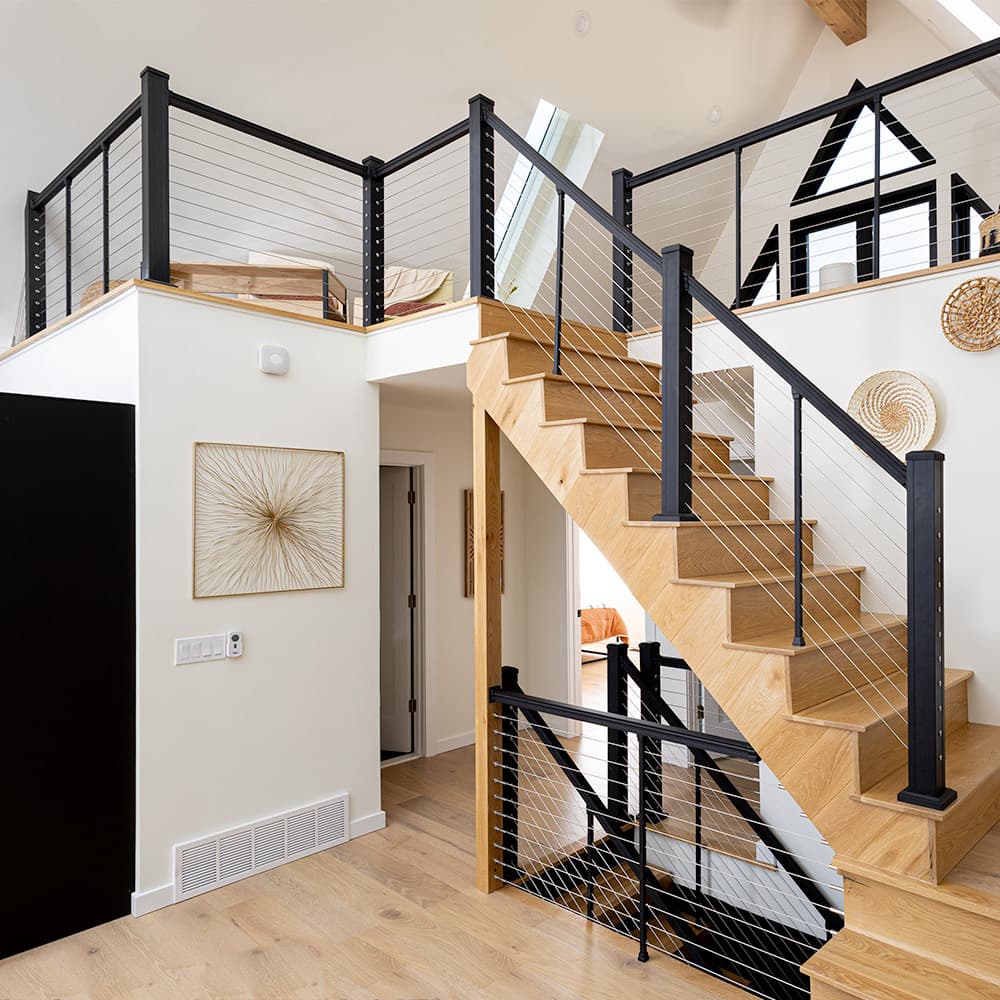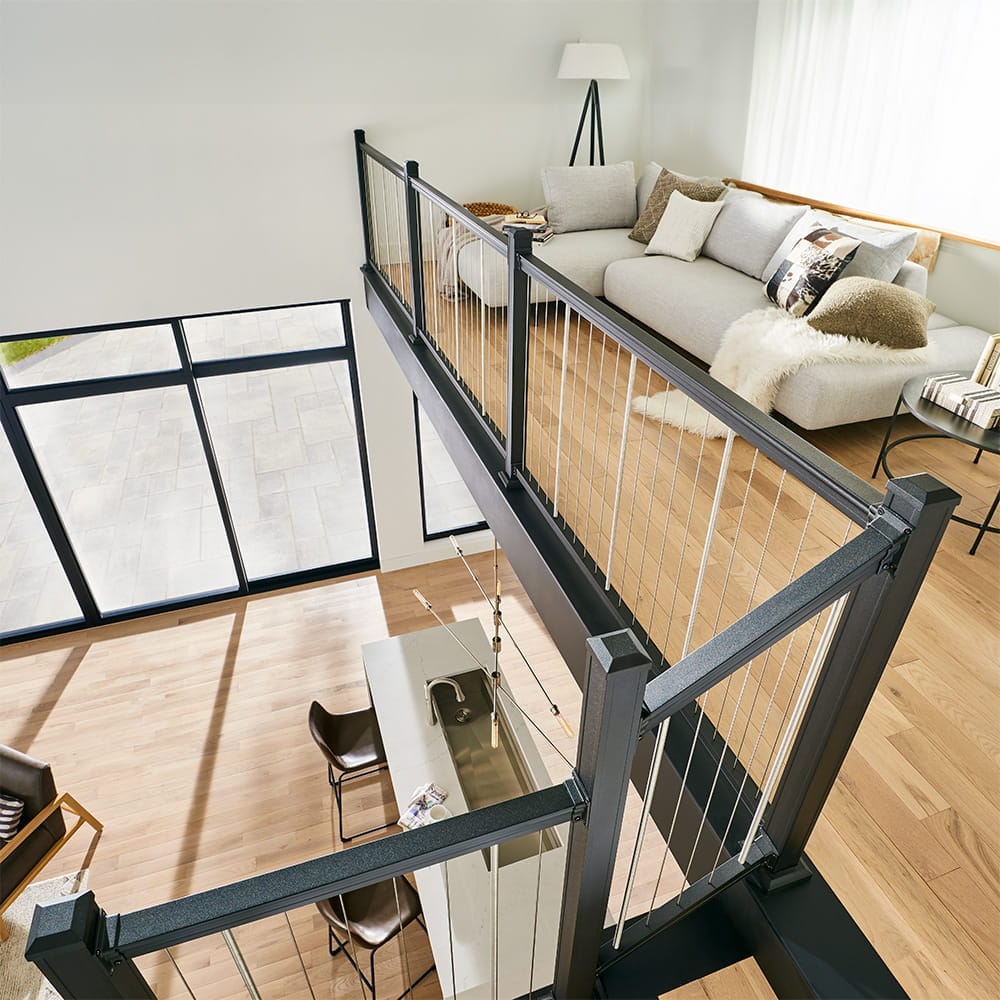Pros and Cons of Cable Railing - Is it worth the Hype

An Insight into Cable Railing

Cable railing is a modern and stylish option in railing design, used in both residential and commercial settings. Celebrated for its sleek, minimalist aesthetic, it offers an unobstructed view, making it an ideal choice for properties overlooking beautiful landscapes or cityscapes. Crafted from sturdy materials like aluminum and stainless steel, these railings promise durability and a contemporary look, effortlessly elevating the overall appearance of your property. Let's delve deeper into the pros and cons of this remarkable railing system to help you decide if it's worth the hype.
Pros of Cable Railing
Sleek and Contemporary Appearance
 One of the foremost advantages of cable railing is its sleek and contemporary appearance. Its minimalist design, characterized by smooth lines and a clean finish, effortlessly aligns with modern architectural trends, making it a go-to choice for those seeking a stylish and sophisticated aesthetic. The uncluttered design of cable railing complements various outdoor spaces, from balconies and decks to staircases, without overpowering the overall look. Moreover, it provides an unimpeded view, allowing you to enjoy your surrounding landscape to the fullest. Its versatility in design also means it can blend seamlessly with different settings and styles, offering a touch of modern elegance to any property.
One of the foremost advantages of cable railing is its sleek and contemporary appearance. Its minimalist design, characterized by smooth lines and a clean finish, effortlessly aligns with modern architectural trends, making it a go-to choice for those seeking a stylish and sophisticated aesthetic. The uncluttered design of cable railing complements various outdoor spaces, from balconies and decks to staircases, without overpowering the overall look. Moreover, it provides an unimpeded view, allowing you to enjoy your surrounding landscape to the fullest. Its versatility in design also means it can blend seamlessly with different settings and styles, offering a touch of modern elegance to any property.
Versatility in Complementing Diverse Architectural Styles
Cable railing is not just for contemporary designs; it holds the remarkable ability to complement a wide variety of architectural styles. Whether you have a classic colonial house, a rustic farmhouse, or a sleek modernist building, cable railing can enhance and blend with your property's aesthetic. The simplicity of its design allows it to become a part of any architectural dialogue without compromising the original charm and character of the building. It can add a modern twist to traditional designs or streamline the look of an ultra-modern property. From rustic to chic, antique to avant-garde, cable railing proves its adaptability, making it a wise and stylish choice irrespective of your property's design.
The popularity of cable railing in modern interior and exterior design cannot be overstated. Interior designers and architects laud it for its ability to deliver an unobstructed vista, lending a spacious and open feel to any space. This plays a key role in contemporary design trends that prioritize minimalism, space optimization, and integration of indoor and outdoor environments. In exterior designs, cable railings are a go-to option for patios, terraces, and decks because they do not obstruct the panoramic view. Whether it's a beautiful garden, a sprawling landscape, or a cityscape, cable railings ensure you have an uninterrupted view, while simultaneously adding to the aesthetic appeal and value of the property. In essence, the popularity of cable railing in modern design is firmly rooted in its ability to enhance views, complement diverse architectural styles, and contribute to the overall aesthetic appeal.
Unobstructed Views
The major advantage of cable railing lies in its ability to offer unobstructed views. With their slim profiles, these railings are designed to be virtually invisible, allowing homeowners to enjoy panoramic views of their surroundings. This distinctive feature is particularly beneficial for properties located in picturesque areas, as the railings do not interfere with the natural beauty of the landscape. Whether you are gazing at a serene beach, a scenic mountain range, or a vibrant city skyline, cable railing ensures your view remains clear and uninterrupted. Furthermore, it creates an illusion of more space, making your property feel larger and more open. Hence, cable railing is not only a design element, but a means to enhance your living experience by connecting you with the outside world.
Cable railing is a perfect element to showcase the picturesque landscapes, lush gardens, and other visually stunning elements. The nearly invisible lines of the railing enable the natural or designed beauty of any space to take center stage. Its minimalist design doesn't interfere with the elements you want to highlight. Instead, it subtly frames them, creating a picture-perfect view from every angle. Whether you're showcasing a blossoming garden, a sunset over a lake, or the architectural finesse of your property, cable railings serve as a subtle and sophisticated frame that highlights these elements rather than overshadowing them. The added benefit is that whether you're on the deck or inside looking out, your views are always unrestricted, adding to the overall appeal of your property.
Low Maintenance
One of the key advantages of choosing cable railing is the minimal maintenance it requires. Unlike traditional wooden railings which need regular sealing or painting to prevent decay, cable railings are made of weather-resistant materials like stainless steel, making them highly durable and long-lasting. They can withstand harsh weather conditions without showing signs of wear and tear. The only routine maintenance required is the occasional tightening of the cables and a periodic quick wipe down to keep them looking fresh. This makes cable railing an incredibly cost-effective choice in the long run, saving homeowners both time and money on upkeep.
Rust and Corrosion Resistance
A standout feature of cable railing is the use of stainless steel cables, renowned for their remarkable resistance to rust and corrosion. This quality makes them an especially appealing choice for all types of climates, but particularly in coastal areas where saltwater can be detrimental to most types of metals. The stainless steel cables remain undeterred by such conditions, retaining their strength and appearance throughout the years. This longevity, combined with its low maintenance nature, means that cable railing is not just an investment in style, but also in durability and enduring appeal. For best results, we recommend using Key-Link's Coastal Finish when installing in harsh saltwater climates.
Durability and Longevity
Cable railing systems excel in terms of durability and longevity, thanks to the use of robust materials. Primarily made from high-grade stainless steel, these railings are designed to withstand the test of time. Stainless steel is known for its remarkable strength, making it resistant to damage, breakage, or deformation even under substantial pressure. As a result, cable railings can handle heavy loads and high stress with ease, maintaining their structural integrity over time. The rigidity of these railings, combined with their rust and corrosion resistance, ensures a stable, sturdy barrier that retains its appearance and functionality for many years. This durability translates into a long-lasting solution that is ideal for both residential and commercial properties, providing a reliable, secure railing system with a touch of modern sophistication.
Versatility
Cable railing is extremely versatile and can be adapted to a wide variety of settings. It can bring a modern, sleek aesthetic to outdoor decks, enhancing the view and creating a sense of open space. Its strength and durability make it an excellent choice for balconies, where safety is paramount, yet without compromising on visual appeal. Cable railing is also a perfect fit for staircases, providing a sturdy and reliable handrail system that doesn't obstruct light or sightlines. The minimalist design of cable railings is equally suitable for indoor spaces, where it can add a contemporary touch to lofts, open-plan apartments, or commercial buildings. Whether it's indoor or outdoor, residential or commercial, cable railing offers a stylish, secure, and durable solution for all your railing needs, proving its versatility.
Design Flexibility
Cable railing's design flexibility is another one of its outstanding advantages. It can be effortlessly combined with other materials, such as wood or metal, to create unique designs that cater to a wide range of aesthetic preferences. For instance, using wooden posts with stainless steel cables can create a perfect blend of rustic charm and modern minimalism, ideal for a cozy, nature-inspired setting. On the other hand, combining cable railing with sleek metal posts can result in a distinctly contemporary and industrial look, suited to modern, urban interiors. The ability to mix and match materials not only allows for distinctive design possibilities but also enables customization to align with the existing decor and architectural style of your home or commercial property. With cable railing, you can achieve a personalized design that is both functional and visually appealing.
Safety
A common misconception surrounding cable railings is that they are less safe compared to traditional railing systems. However, this is far from the truth. In fact, cable railings are designed with safety as a prime concern. The cables are extremely strong and durable, capable of withstanding substantial pressure without breaking or becoming loose. This makes them an excellent choice for safeguarding spaces like balconies, decks, and staircases. Moreover, their design includes tightly spaced cables that prevent small children and pets from slipping through. Indeed, when installed correctly and to code, cable railings can provide a safe, secure barrier without sacrificing style or views. So, whether it's a high-rise balcony or a residential staircase, you can rely on cable railings to provide a secure environment while enhancing the aesthetics of your space.
Compliance with Safety Standards and Codes
When installed correctly, cable railings adhere to stringent safety standards and building codes. They are crafted to meet the requirements defined by local and international regulatory bodies for load resistance and balustrade spacing to ensure optimal safety. This means, a well-installed cable railing system won't just withstand the pressure exerted on it, but it will also have the right cable tension and correctly spaced cables to prevent accidental falls or slips. Therefore, when opting for a cable railing system, it is important to work with a reliable supplier who understands and respects these codes. This way, you can guarantee that your railing is not just aesthetically pleasing, but also compliant with safety regulations, giving you peace of mind.
Cons of Cable Railing
Initial Installation Complexity
While there are numerous advantages to cable railings, it's worth noting that their initial installation can be more complex than traditional railings. This complexity arises from the need for precise measurements, exact cable tensioning, and adherence to stringent safety standards. Unlike standard railings, which can often be installed with simple tools and a basic understanding of carpentry, the installation of cable railings requires a deeper level of expertise. Therefore, it is recommended that you enlist the help of a professional installer who is familiar with cable systems. This will not only ensure that your railing meets all safety regulations, but also that it performs optimally in terms of durability and aesthetics.
Precision and Tensioning in Cable Railing Systems
Precise measurements are pivotal in the installation of cable railing systems. The spacing between the cables, their tension, and the distances between the posts are all crucial elements that can significantly influence the final appearance and the safety level of the railing. Adhering to accurate measurements ensures that the aesthetic appeal of the railing is not compromised, while also keeping it compliant with safety standards. Furthermore, the tensioning of the cables is a process that requires special tools such a tensioning gauge. A cable that is too slack can lead to safety hazards, while an overly tightened cable can exert excessive pressure on the posts and the overall system. Proper tensioning guarantees an optimal balance between safety, durability, and elegant aesthetics in your cable railing system.
Cost Implications of Cable Railing Systems
It's important to be aware that the unique features and benefits of cable railing systems come with a potentially higher upfront cost compared to traditional railings. This cost difference arises primarily from two factors: the materials used and the specific installation requirements. Cable railing systems are typically made of high-quality, durable materials such as stainless steel, which, while providing excellent longevity and minimal maintenance, do cost more than materials used in standard railings.
The installation of cable railings also contributes to the overall cost. Given their complexity and the precision required for measurements and cable tensioning, professional installation is often recommended. While this ensures adherence to safety standards and enhances the railing's durability and aesthetics, it also means additional labor costs. Therefore, while the initial investment in a cable railing system may be higher, it's crucial to consider the long-term benefits of durability, safety, and superior aesthetics when comparing costs.
In light of the higher upfront costs, it's essential to view your investment in a cable railing system in a broader perspective. While it is true that the initial outlay may be more than that of a traditional railing system, the long-term benefits of a cable railing system cannot be overstated. The superior durability of stainless steel saves on maintenance and replacement costs in the long run. Additionally, the elegant aesthetics elevate the value of your property, providing a return on your investment. Hence, when considering the cost implications, it is crucial to factor in these long-term benefits, as they often outweigh the initial investment.
Required Maintenance
Although cable railings are renowned for their durability and low maintenance, they are not entirely devoid of upkeep requirements. Like any other home installation, to maintain their pristine condition and functionality, occasional inspection is necessary. This mostly involves checking for any loose cables or signs of wear and tear. Additionally, over time, the tension of the cables may decrease due to regular use or weather conditions. In such cases, retightening might be necessary to restore them to their optimal tension. Even with these minor maintenance needs, cable railings remain a convenient, long-lasting option for your property.
Not Ideal for Certain Settings
It's important to note that cable railings may not be the ideal choice for environments with specific safety requirements. This includes settings such as childcare facilities or locations where small children frequently play. Due to the gaps between the cables, there is a risk that small children may try to climb or squeeze through, presenting a potential safety concern. Therefore, while cable railings offer an elegant and durable option for many settings, they might not meet the safety standards required for certain environments. It's always essential to consider the specific needs and requirements of your setting before deciding on the most suitable railing system.
Alternatives that Meet Specific Safety Regulations
In situations where cable railings might not meet specific safety standards, there are a number of alternatives that can be considered. Traditional wooden or vinyl railings, for instance, offer a solid, closed design that mitigates the risk of small children squeezing through or attempting to climb. Furthermore, glass railing systems provide a sleek, modern aesthetic similar to cable railings, while also offering a full barrier, enhancing safety in environments frequented by children. Additionally, mesh railing systems can serve as a compromise between the aesthetic appeal of cable railings and the safety requirements necessitated by certain settings. Each of these alternatives brings its own set of pros and cons, so it's critical to thoroughly evaluate your specific needs and potential options before making a final decision.
Cleaning
Maintaining the luster and elegance of your cable railing system calls for routine cleaning. We suggest using approved cleaning solutions such as 409®, Spraynine®, Simple Green®, Fantastik®, or Windex®. These solutions are gentle on your railing while effectively removing dirt and grime.
Develop a consistent cleaning schedule, preferably bi-annually, to avoid buildup of grime or residues. During cleaning, apply the solution using a soft cloth, sponge, or soft bristle brush to prevent any scratching or damage to the railing surface.
If your railing is situated in an environment prone to high dust or grime, consider pressure washing. However, do not exceed a pressure of 400 PSI to avoid damaging the railing's structure. Always remember to rinse the surface thoroughly after cleaning to remove all residues and prevent any potential staining or discoloration. By following these simple cleaning tips, you can ensure that your cable railing system maintains its sleek, modern aesthetic for years to come.
Conclusion
In conclusion, cable railings present a compelling choice for those seeking an amalgamation of style, function, and durability. Their modern, sleek design enhances the aesthetic appeal of any space, while their transparent nature ensures unobstructed views. Moreover, they require minimal maintenance, with routine cleaning sufficient to retain their polished appearance. Durability is another key advantage of cable railings, as they are crafted with robust materials that withstand the test of time. Additionally, they boast an impressive versatility, adaptable to various architectural styles and settings. Finally, despite misconceptions, these railings also offer considerable safety, especially when installed correctly and used in the suitable environment. Thus, considering these significant benefits, cable railings can undoubtedly be an excellent investment for your property.


